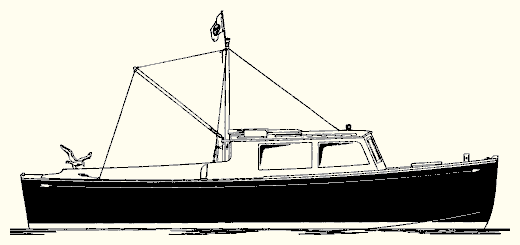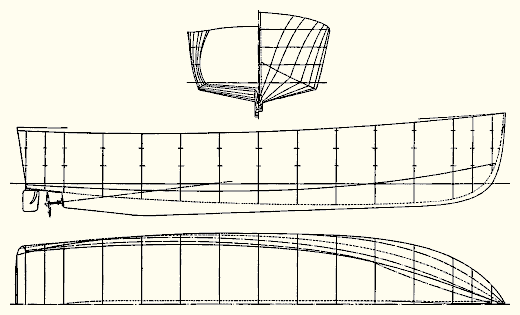
| Capt'n Frank A 28' 3" V-Bottom Sedan Fishing Cruiser By William Atkin |
| A Wholesome Sedan Type Cruiser | |
| There seems to be a feeling in the air for more wholesome motor boats. Not a week goes by in which I fail to receive several letters asking for stock plans or special plans of motor boats that are also sea boats; not old-fashioned boats, rather boats of modern design but with far less top-hamper than most current boats show. These letters come from salt water watering places and it is astonishing how many boats are used for pleasure fishing. These craft will go offshore 20 to 30 miles and to be caught out is risky business unless there is plenty of boat below and very little windage and weight above. Furthermore, most of these fishing boats are obliged to gain the sea by passing through small inlets and over bars. Under average weather conditions the passage may not be too difficult; but if the wind freshens against the tide one needs more than a "powder-puff" boat to get through safely. One must remember, too, the trip home means again getting through the inlet, because there is no other way back. All of which calls for a wholesome and able boat. Wholesome and ableboats are in demand for cruising wherever the water is likely to become rough. And sooner or later I have learned water will become rough. Therefore it is comforting to know that the boat you are in is staunch and is designed for use despite the weather and will be a well-behaved craft on smooth seas as well. Thus we have the V-bottom motor boat Capt'n Frank: 28 feet 3 inches over all; 27 feet water line; 8 feet 5 1/2 inch breadth; and 1 foot 10 1/2 inch draft. And thus we shall have an excellent kind of boat providing this thing, that, and the other thing is not changed as the work progresses. | |

| |
| The deck plan shows a self-bailing cockpit 9 feet 8 inches long by 6 feet wide. There is an after deck worthy of the name and something over a foot wide deck all around the cockpit and deckhouse. It does seem to me that the little room sacrificed inside is well lost if comfortable and safe foot room is gained on the deck, and, of course, the more width to the side decks, the more strength the boat will have. The cockpit floor is well above the water line and so it is not necessary to have a box over the motor. Also the high cockpit floor gives proper vision to every one in the cockpit, and especially to the man at the wheel. The usual athwartship seat is not in the after end of the cockpit; if the boat is to be used for fishing the seat will be in the way. The steering wheel with instrument panel, throttle control, choke, and compass will be on the wheel box; clutch control will be on the bulkhead. The mast and lifting boom are not necessary but will be handy shipmates, futhermore give individuality and character to the boat as a whole. | |

| |
| The interior is laid out in a simple manner and should be comfortable for two. The galley end of the cabin is 3 feet 1 1/2 inches long and is fitted with ice box with counter top above, work table with single-burner Primus stove, small sink, and room for dishes. There is locker space below the work table. The cabin bunks are 6 feet 3 inches long. A water tank having a capacity of 25 gallons is installed beneath the starboard bunk. Space beneath both bunks is available for locker room. A water closet is installed under the forward deck as shown. Notice the row of hooks for clothes and the locker forward of the low bulkhead in which to stow anchor chain or rope. The headroom beneath the cabin top beams is 5 feet 11 inches and the headroom in the toilet room is 3 feet 9 inches. | |

| |
| The lines show a hull having straight sections below the corners of the chines and moulded sections from the chines to the sheer line. This has proved to be a combination that produces an excellent kind of boat and providing there is ample topside flare the boat will be dry in rough water. The deadrise is deep forward and has unusual continuity as it approaches the stern, and here there is modest deadrise. The result of this is that the chines have a nice sweep from station 7 to the stem as well as to the stern. If buttock lines are drawn at one-quarter-beam intervals these will also show lift. This lift in the after end of the hull-form will prevent the boat from yawing when running off a sea. It also means that if the boat is driven at speeds over 16 to 17 miles an hour the stern will settle. And therefore it is not advisable to put in too much power. A motor like the Gray shown in the plans and having a cylinder displacement of approximately 244 cubic inches should give Capt'n Frank a speed of close to 15 miles an hour. The freeboard is ample for rough water service. The bottom of the keel extends in a straight line from station 2 to a point 1 foot forward of station 9 where it curves upward into a straight line through station 10 and ending at station 11. This form of keel gives excellent protection to the shaft, propeller and rudder and is a form that has a minimum of resistance to the flow of water into the propeller. The breadth, 8 feet 5 1/2 inches, permits plenty of room inside, wide footing each side the deckhouse, and is in wholesome proportion to the overall length. Wide boats are likely to be uncomfortable boats in rough water and require excessive power; wide boats roll quickly and are likely to pound. Very narrow boats have faults, and so it becomes a compromise to fit the breadth to the length. Fact of the matter is everything that goes into the design of a boat is a compromise; the difficulty is to know how to arrive at the most desirable compromise. | |
| Plans for Capt'n Frank are $100 MYSTIC SEAPORT MUSEUM SHIPS PLANS STORE https://store.mysticseaport.org/ships-plans/ shipsplanstore@mysticseaport.org
+1 (860) 572 5360 | |
| BACK TO PLAN LIST | |